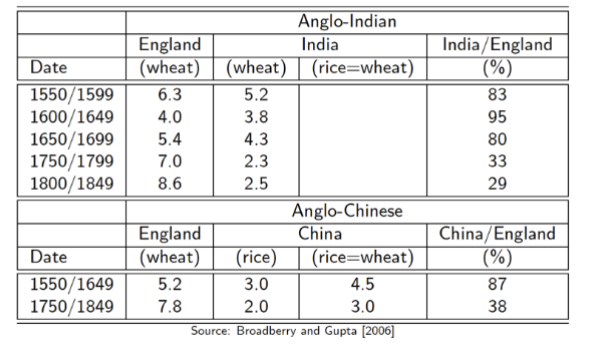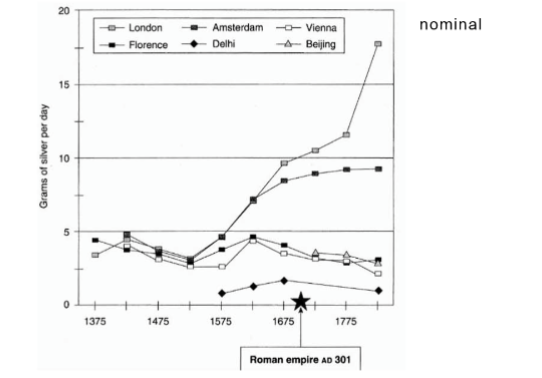5 - Pre-modern growth - great divergence- WHEN
1/24
There's no tags or description
Looks like no tags are added yet.
Name | Mastery | Learn | Test | Matching | Spaced |
|---|
No study sessions yet.
25 Terms
What was the “Great Divergence”?
started in late 18th C
china had been richer and more scientific than Europe
China was urbanized and had stronger sophisticated government
China developed inventions - paper, gun powder, printing, the compass
europe underwent an industrial revolution and was clearly ahead
Europe opened up an increasing gap
What does “The Great Divergence” look like on a graph?

What does everyone mostly agree on about the great divergence?
china was the world leader in terms of GDP per capita at the turn of the first millennium (Song Dynasty)
china remained the largest and most advanced Asian economy until the Industrial Revolution
China produced much of the worlds manufacturing output (1/3 of the manufacturing output of the 19C)
By 19C china was considerably behind North Western Europe in terms of GDP per capita
Japan began to catch up with China and Europe in the 18C
Japan eventually overtook China (18C) and Europe (20C) in GDP oer capita reversing the divergence
What was the Revisionist view?
divergence was a product of 19 C increasing returns (Europe = Asia before 1800)
This was likely the result of coal, colonial policy and historical shocks (Opium Wars 1940s, Taiping rebellion 1850-1864 and the Nian rebellion 1851-1868)
Emphasis on resources advantages and constraints, negative colonial rule, European trade network and inappropriate national comparisons
Empirically based on “grain” wage comparisons between Europe and select Asian regions (Yangzi Delta, Southern India)
Main authors include Pomeranz(2000), Frank (1998), Wong (2000),
What was the traditionalist view?
classical view - (Europe > Asia 1800) but with a focus on North West Europe
NW Europe was likely ahead at an early stage due to its institutons
Emphasis is on commerical expansion (“Commercial revolution”), urbanisation, agricultural productivity (“agricultural revolution”), high wages and cheap energy (“Industrial revolution)
Emprically based on “silver” wage comparisons between Europe and select Asian Regions (Yangzi Delta, Southern India)
Main authors inc Maddison (1998), Broadberry and Gupta (2006), Allen(2005, 2007, 2011) Saito (2009) and Li and Van Zanden (2012)
Late great divergence
How do we assess opposing views
Quantitative evidence
What are the 2 main types of quantitative evidence
Wages
Revisionists look at relative grainw ages
Traditionalists look at broad measures - welfare baskets, silver wages
Income
Revisionists reject reliability of income data
Traditionalists use National Accounting
What did the daily grain Wages of unskilled Labour look like?

Why do traditionalists believe that grain wages comparison dont make sense?
Should rather consider “silver wages”
less developed countries (LDCs) meet the food needs of the population with LDC food prices
Developed country food prices are much higher
Manufactured goods and luxury goods are expensive in LDCs
The only way to really account for all types of goods is to convert wages into currency (gold or silver) and then readjust for prices
Then one can look at the purchasing power for various comparable baskets of goods
Early great divergence
What does the daily silver wages of unskilled labour (g per day) comparison look like?

What does the cross country comparison of silver wages look like - Allen 2009?

Whats a summary of the nominal wage difference?
real grain wages were low but comparable up to the 17C
Asian grain wages diverged from Europe in the 18C
Silver wages show very early divergence around 15C
South indian silver wages were one-fifth of the English level in 16C
Silver wages in Yangzi delta were much lower than England by the late Ming period (1573-1644)
Supports an early great divergence
How do we determine the standard of living?
We need to compare PPP adjusted wages:
to do this we need to adjust wages by relative prices
Prices are calculated for a weighted “representative” basket of goods
What are Allen (2011)’s 2 basket options for comparative studies?
“European Respectability” Basket (ERB)
supplies 1940 Kcal
Based on 18C budget and basic diets
“Bare bones basket” (BBB)
Supplies 1940 Kcal
Based on a smaller amount of your basic goods such as meat (very little non-food consumption)
What can PPP adjusted silver wages tell us?
Allen calculates “welfare ratios”
number of times a family can buy ERB or BBB
Assumes one male full-time worker and a full year of work
Assumes average family has a husband, a wife and 2 children
Annual cost of subsistence = 3.15 times the basket (0.15 for rent)
Welfare Ratio = 1 implies family can just afford it
What does Welfare Ratios tell us?
we should expect similar results from ERB and BBB
Divergence will be grater with ERB than BBB
Summarise the real wage evidence?
Everyone is surprisingly rich in 1400
plague hit
NW Europe stays rich after 1400
London and Amsterdam families 3-4 times subsistence
Rest of the world returns to low wages around 1500-1700
How was Malthus right about the pre-modern world?
most families globally are barely able to survive between 1400-1900
Population growth must have eaten up the gains from plague
What do Broader measures reveal about the Great divergence?
Deeper aspects
grain wages show us that CHina is not behind in terms of agriculture
silver wahes sjow that china fell behind in terms of manufacturing and services
Asia has much poorer access to broader consumables
What are the issues in real wage evidence?
are families the same size across countries/ regions/ sectors/periods?
Do only men work?
What about unskilled labour?
What happens if we apply national Accounting Methods instead of real wage evidence?
income can be estimated from production or expenditure
this can be done by sector and then aggregated to the whole economy
We can adjust this by producer prices to get PPP adjusted real output
Why were the 1st attempts at National Accounting less precise?
Europe was reasonably well estimated but not Asia
Chinese GDP per capita was rather “shaky”
How does recent updates give us a better understanding of the Great Divergence?
China was rich during Song dynasty - “Song Peak”
China stagnated from 14C hitting Malthusian constraints
China actually declined from 18C instability
China was always relatively productive in agriculture
China fell behind in industry - mainly clothing and textiles
china fell behind in services - mainly commerce, banking and transport
What are the Little divergences?
Within Europe
southern europe was ahead in 1400 - falls behind by 1600
The Netherlands was ahead in 1600 - falls behind by 1700
Britain was ahead around 1700 - remains ahead until 20C
Within Asia
China was ahead in 900 - falls behind by 1700
Japan was ahead in 1700 - remains ahead until 20 C
India effectively catches up to China around 17C
What do we learn from the divergences?
countries rise and fall - long-run success vs short-run success
‘Golden Ages’ do not lead to sustained growth - not until the Industrial Revolution
Trade matters - Italy, Netherlands and britain all has trading empires
Overall Europe has had a long history of economic success
Asia has had a long history of economic decline